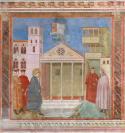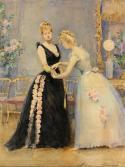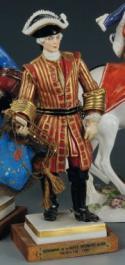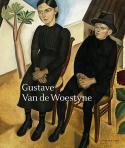Art Of The Day Weekly
#170 - from 15 April 2010 to 21 April 2010
Willy Ronis comments his most famous shots in a 2005 interview (AFP (M. Hospital and A. Benoit). Willy Ronis Exhibition at the Monnaie de Paris from April 16, 2010.
IN THE AIR
Leonardo's herrings
We have seen certain paintings so many times that we no longer know how to look at them. Everyone knows Leonardo’s da Vinci’s Supper, a fresco kept (in a very bad state) in Milano. But who has really looked at its details, or who has deciphered the clothing, the furniture, or the plates? A group of Canadian researchers from the theology department of the University of Montreal had fun doing just that. They drew up the shopping list, they interpreted the salt shaker lying down and the empty plate in front of Judas as symbols that are in line with the Da Vinci Code. The food is even more troubling. Why did they eat fish that day? Simple, because most of the apostles were fishermen from the Sea of Galilee. But why eel and/or herring? Once again, their symbolic value seems to be the reason: eels are slippery and slimy. But so are eels: in Leonardo’s time, in Northern Italy, that fish was already referred to as renga, a renegade. Who would have guessed a cookbook can be of greater help than a thesis on history of art to understand major painting …
EXHIBITIONS

Giotto, Homage of the simple man, Assisi, Basilica superiore, © HAL9000 Srl Novara, Italy, www.haltadefinizione.com, su concessione della Custodia Generale del Sacro Convento di San Francesco in Assisi
Giotto, the original version
ASSISI -An earthquake caused irreparable damage to Umbria’s cultural heritage 13 years ago. The frescos from the basilica of Assisi were among the most famous victims. But restorers armed with patience helped recover thousands of fragments and recompose a part of the paintings. The exhibition offers visitors the privilege of climbing up on the scaffoldings in the chapel of San Nicola of the lower basilica, to see up-close the nature of their work. The second part of the exhibition carries us to a virtual world, and after admiring in the superior basilica the 28 scenes of Saint Francis’ life done by Giotto, digital reconstitutions, in the recently restored palace of Monte Frumentario, give them back their original colors: a deluge of intense blues and reds, on the verge of being loud!
•I colori di Giotto in the basilica of Assisi and at the Palazzo del Monte Frumentario, from 11 April to 5 September 2010.

Brussels workshop. Hanging Great acts by Scipio. Battle of Zama. Probablement de Balthazar Van Vlierden. D’après des cartons de Jules Romain. Laine et soie. 4,96 x 9,25m. © Patrimonio Nacional, Madrid.
Tapestries from the Habsburgs
PARIS - These tapestries had not been seen so close in Paris in over a century, when these wonders from the Royal Spanish Collections were presented during the Universal Exposition in 1900. Twenty of them are back today to celebrate the Spanish presidency of the European Union. This is only logical, since after all they pay tribute to just that, to Europe. The tapestries were commissioned from Madrid by either Charles the Fifth or Philip II, drawn by Flemish (Jérôme Bosch) or Italian (Giulio Romani) artists, woven by masters from Brussels, and then continued their travels throughout the peninsula, from one palace to another. They were woven in silk, wool, gold and silver thread, illustrated inspiring mythological episodes and were then as prized as jewellery or ceremonial silverware.
•Trésors de la Couronne d’Espagne, un âge d’or de la tapisserie flamande (Treasures of the Spanish Crown, a golden age in Flemish tapestries) at the Mobilier national, from 15 April to 4 July 2010.

Madeleine Lemaire (1845-1928), Avant le bal, circa 1887-1888, watercolour, 33 × 25 cm, private collection, © Studio Sébert-Photographes
Women's salons
PARIS - One often associates salons with the age of the Enlightenment. Actually, the phenomenon lasted until the beginning of the XXth century. In the times of Proust, Manet and Gabriel Fauré, intellectuals would meet at the princess of Polignac’s or at Marguerite de Saint-Marceaux’s. Four of those feminine salons from the years between 1875 and 1910 have been brought back to life in a venue that befits them perfectly, the Marmottan museum, a private home from the same period. These strong-willed women knew how to defend and impress their admirers – Proust drew his inspiration largely from the fauna he met in their salons. But they also knew how to create their own works. It was the case of the emblematic Madeleine Lemaire, a distinguished watercolor artist, who was decorated with the Legion of Honor before falling into oblivion. The careers of Rosa Bonheur and Berthe Morisot would also greatly profit from these social gatherings.
•Femmes peintres et salons au temps de Proust (Women painters and salons at the time of Proust) at the musée Marmottan Monnet from 15 April to 6 June 2010.
. Do not miss:: Mrs Delany and her circle at the Sir John Soane Museum in London (until 1st May 2010), on a society of women artists at the end of the XVIIIth century.
Artoftheday also recommends...
• The very rich collection of Islamic art of the Aga Khan will soon be exhibited in a museum designed by Fumihiko Maki, in Toronto. While awaiting its inauguration, to take place in 2013, the Martin Gropius Bau in Berlin presents a few major pieces. Until 6 June 2010.
• The author of light-filled paintings, famous in his native Denmark, Christen Kobke (1810-1848) will finally benefit from a retrospective abroad, at the National Gallery in London. Until 13 June 2010.
•Willy Ronis a photographer loved by the public at large as much as Doisneau or Boubat, and who recently passed away, is the object of a retrospective at the Monnaie de Paris. From 16 April to 22 August 2010.
AUCTIONS

Lot n°31, Trumpet player from the Guards of the King's House, circa 1740, porcelain figurine from Saxe (Meissen) polychrome. Height: 21 cm. Estimate: €800-1200. Courtesy Binoche Renaud Giquello, Paris
Medals, swords, standards...
PARIS - Amateurs of decorations should be able to satisfy their passion: there is a true cascade of them in this sale, from the French Légion d’honneur to the crosses of Tonkin, Mexico, Madagascar, Dahomey, or the Voluntary Engaged miners in the war of 1870 (starting at 10 €, up to more than 2000 € for a plaque of a knight of the French Restauration period). Among all this avalanche of militaria, one will discover touching things such as these ivory miniatures of army surgeons or officers of the artillery train. Papers from all times can be looked at as simple historical documents or as a slice of history to be hung on the wall – from the «full leave» for a king’s musketeer to the recruitment posters of the regiments in the Languedoc region, up to a «general painting of the French troops», a manuscript with illustrations in water-colors (lot 306, 200 €). It was drawn-up on the eve of the Revolution, on 1st August 1788, and is one of the last souvenirs from the Ancien Régime. Slightly more troubling is this stiletto (lot 403, 400 €) with which the deputy from the Gironde Dufriche-Valazé committed suicide on 30 October 1793 when he learned he was condemned …
•Souvenirs militaires at Richelieu-Drouot (SVV Binoche-Renaud-Giquello) on 19 and 20 April 2010.
ARTIST OF THE WEEK

Shimabuku, Something to Float / Something to Sink, 2010, aluminium, water, electical system, lemons, 2 x (49 x 80 x 80 cm) © photo Marc Domage courtesy Air de Paris
Shimabuku and nature
Everyone has played at the game of seven errors, to be able to detect the slight differences between two images that seem identical. It helps to fill in the long summer evenings … Japanese artist Shimabuku (born in 1969) enjoys the same hobby. But he has a much more militant thought in his mind. In our globalised world, it seems obvious that diversity is increasingly the victim of standardization. What first affected our way of dressing, our look, our reading, now affects Nature itself. Tomatoes have become practically industrialized and have lost their shape, their patterns as well as their taste. They are all so alike that originality is now found only in the secondary qualities of the object. How can one make a difference between a tomato and a tomato, and soon, between a tomato and a kaki? Shimabuku’s mission is to find identity in details.
•Shimabuku is exhibited at the Air de Paris gallery (32 rue Louise Weiss, 75013 Paris), until 30 April 2010
BOOKS
Van de Woestyne, a Flemish mystic
When painters started to enjoy working in contact with nature, various schools were born, over a good 50 years. Barbizon is emblematic of that phenomenon. In Belgium, the more recent school of the Lys, marked by Symbolism, was the main one. Among that group of painters settled along the river, Gustave Van de Woestyne is one of the most disconcerting. His style drew meanders throughout his life (1881-1947), going from religious compositions influenced by the contribution by Maurice Denis to peasant scenes, an update of Brueghel and Jerome Bosch. On the contrary in his portraits of worldly men and of members of his family, he is closer to the neo-Classic current, as represented by Achille Funi in Italy at the same time. This book is the catalogue of the exhibition currently dedicated to him at the musée des Beaux-Arts in Gand, and it deciphers his work by following a chronological system that lends itself easily to the presentation of his successive infatuations.
•Gustave Van de Woestyne, Robert Hoozee and Cathérine Verleysen, Fonds Mercator, 2010, 258 p., 44.95 €
IN BRIEF
COLOGNE – The 44th edition of the modern and contemporary art fair, Art Cologne will be held from 21 to 24 April 2010, with nearly 180 galleries.
MEXICO – The MACO contemporary art fair, will be held from 14 to 18 April 2010
MILAN - The Salone internatzonale del mobile is held from 16 to 19 April 2010.
NANCY – The 16th Biennale of images of Nancy, which associates young creators and confirmed artists, will be held from 17 April to 4 May 2010.
PARIS – The SLAM, the international fair of old books, and the print fair, will be held jointly at the Grand Palais, from 16 to 18 April 2010.
ON ART-OF-THE-DAY.INFO
This week, do not miss

ARAGON AND MODERN ART
PARIS - The Adresse Musée of the Post Office presents the rich exchange, over more than half a century, between Aragon and contemporary art. From Matisse to Pirosmani, from Chagall to Titus-Carmel, the founder of Surrealism cultivated a special link with the creators of his time.

GANDHARA PAKISTAN - LAND OF ENCOUNTERS
PARIS -The musée Guimet presents some 200 works of the Gandhara culture, an ancient Hellenistic kingdom that covered the North-Western provinces of what is today Pakistan. It reached its peak between the Ist and IIIrd centuries, at the time of Alexander the Great’s successors.

